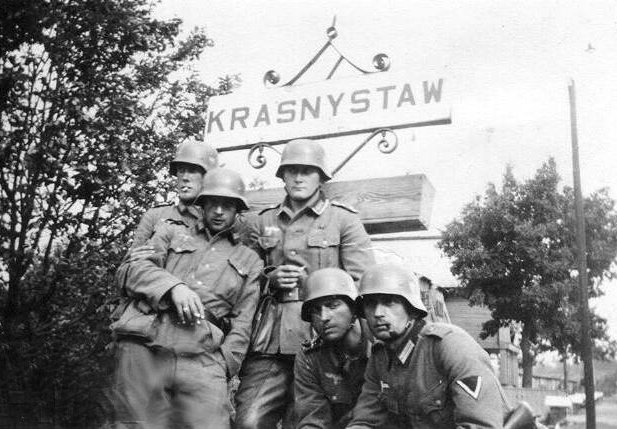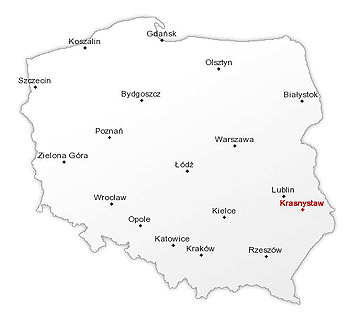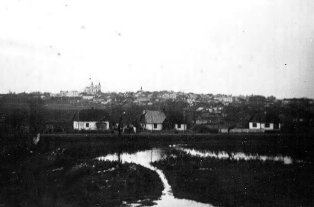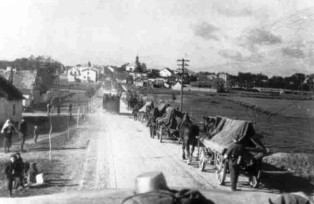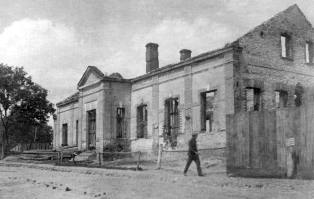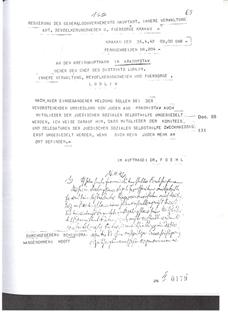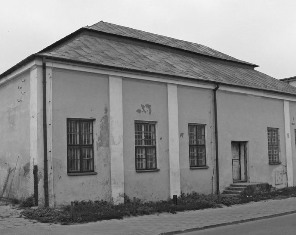Holocaust Education & Archive Research Team |
Ghettos
Introduction to the Ghettos of the Holocaust
Jewish Ghettos The Judenrat Judenrat Leaders Prominent Jews
| ||||
Krasnystaw
Krasnystaw was not a typical Jewish community of the Lublin region. Whereas in most of the provincial towns of the Lublin voivodeship before the war, Jews formed a majority of the inhabitants, in Krasnystaw they represented a minority. Jews settled in Krasnystaw later than in other towns of the region. Until the beginning of the 19th century Krasnystaw was the residence of the Roman Catholic Bishops of Chelm, and Jews were not permitted to settle in the town (a similar regulation was in place in other Bishops' residences in central Poland, for example in Kielce).
It was only in the first half of the 19th century, when the governance of such towns was changed by the Russian administration from religious to state jurisdiction- that these anti-Jewish regulations were abolished and Jews could settle in such places. The Jewish population grew rapidly, but up until the outbreak of WW2, Krasnystaw was not among the largest Jewish communities of Krasnystaw County. The most active Jewish community in this region was in Izbica, located only 14 km from Krasnystaw, where the number of Jews was much greater. Shortly before the war about 2,500 Jews lived in Krasnystaw out of a total population of 10,000. Krasnystaw was a typical shtetl and most of the Jews were merchants and artisans.
Not far from Krasnystaw, in the village Borowica, Szmuel Zygielbojm, one of the leaders of the Bund (Jewish Socialist Party) in Poland, and during the war a representative of the Polish Government in Exile in London, was born in 1895. In 1943 he committed suicide on the final liquidation of the Warsaw Ghetto. His suicide was an act of protest against the indifference of the world in the face of the annihilation of the Jews of Poland.
On 14 September 1939 German units captured Krasnystaw after a short battle, and during the next few days German soldiers looted valuables and goods from many Jewish families in the town. In addition, 13 Jews from Krasnystaw were executed as hostages at that time on the grounds that the Jews had organised resistance against the German army during the fighting in this region.
Jews were also forced to work as slave labourers for the German Army, which was a common occurrence during the early days of the occupation..
On 24 September 1939 the Soviet Army, which had invaded eastern Poland on 17 September, arrived in Krasnystaw and remained there for about two weeks. During the subsequent withdrawal of the Soviet Army, many Jews, especially younger members of the community, decided to leave with them. However, it is difficult to accurately estimate how many Jews went with the Soviets.
The first Judenrat in Krasnystaw was established at the beginning of 1940. The President of this institution was Lipa Reichman. Other members were Issachar Rozenbaum, Alter Katz and Dawid Zylbercan. Survivors from Krasnystaw did not have a good opinion about their activities. Some members of the Judenrat were accused of bribery and collaboration with the German administration.
From its inception, the Judenrat was responsible for collecting the money and valuables that constituted the contributions demanded by the Nazis. The Jewish police of the town were also very active during these collections.
Most of the members of the Jewish police were friends or relatives of Judenrat members. Among the Jewish policemen were Ben-Zion Rozenblat, Mosze Szmaragd, Josef Zylbercan and Zanwel Mittelman. In comparison with other towns in the Lublin district, the ghetto in Krasnystaw was established very quickly in August 1940. The German administration in the town (Krasnystaw was the county town for the whole region) decided to remove the Jews from the town centre, officially claiming that Krasnystaw had been destroyed in September 1939 and that German institutions required more space for themselves.
At that time 1,690 Jews lived in Krasnystaw. All of them were resettled to the suburb of Grobla, to a very tiny area in a very poor part of the town. There were only small wooden houses in Grobla, which is naturally separated from the town itself by the Wieprz River. There was no supply of electricity in this district and water could only be obtained from the river or from one of several wells. At first the ghetto was not closed, but Jews were not allowed to enter the centre of Krasnystaw. During the move to the ghetto and later, particularly before the German invasion of the Soviet Union in 1941, a group of 300-400 Jews was resettled to Izbica and to the neighbouring village of Siennica Rozana.
The official order concerning this resettlement from Krasnystaw stated that the German army required more space for its troops. Before the invasion of the Soviet Union, German soldiers attacked the ghetto several times, assaulting Jews on the street (the ghetto consisted of a single, long street) and plundering their homes.
In 1941 the main synagogue was destroyed, in the town centre today in ul. Czysta stands the synagogue building erected in 1906. There is an abandoned Jewish Cemetery where the Borek forest ends, some of the tombstones still visible date back to the 19th century. In 1941 the ghetto was closed, and surrounded by barbed wire. Simultaneously, a work camp for Jews was organised in Krasnystaw, close to the Borek Forest, and Jews working for the Wehrmacht (Heeresmunitionslager / ammunition depot for the armed forces) were initially taken there every day. In 1942 two barracks were built for the prisoners at the labour camp, where they lived until the liquidation of the camp.
As the Kreishauptmann explained, this resettlement from Krasnystaw was necessary because the first transports, containing deported Czech and German Jews, had already arrived in Krasnystaw County and the Germans required space to accommodate them. Most of the foreign Jews were settled in Izbica, Krasniczyn and Gorzkow.
Foreign Jews were not settled in the Krasnystaw ghetto; however, a group of about 400 Czech Jews, mainly young and strong men, were selected from the transports and were sent to the work camp near the Borek Forest.
On 12 May 1942, a large-scale deportation from Krasnystaw County to the Sobibor death camp began. Thousands of Jews were taken to Krasnystaw town from all over the county. They had to walk many kilometres. All of them were gathered in an unfinished school building located at the edge of the Grobla Ghetto and opposite the railway station.
In this overcrowded building, which did not yet contain windows, without food or water, people waited for the transports to the death camp. Pregnant women gave birth there. The selections took several days. Approximately 600 men – Polish, German and Czech Jews - were deported to KL Majdanek. All others were deported on 14 May to Sobibor. Among them were about 700-800 Jews from Krasnystaw, 1,000 from Zolkiewka, 500 from Wysokie, 2,000 from Turobin, 1,000 from Izbica, 1,000 from Gorzkow, and some 500 from Siennica Rozana and Fajslawice – a total of 6,700-6,800 men, women and children. Dov Freiberg, a survivor of Sobibor, who was amongst those deported from Turobin, described this deportation: "On 12 May, SS-men and Ukrainians surrounded the town. Early in the morning, they announced that we were going to be deported and that by 9 o'clock all Jews should be in the town square. I came there with my aunt. My uncle and their children went into hiding. I was so fed up with the life we had been leading that I decided to go, but it didn't occur to me that we were going to be sent to a death camp. At the square were carts for the children and for the bundles. All the rest were compelled to go on foot. Many people, the elderly and sick and those found in the houses, were shot on the spot. Close to me was a paralysed man in a wheelchair. An SS-man approached him, put his gun to the man's head and pressed the trigger. No shot came. The man's face convulsed, his eyes filled with tears, but the SS-man continued his 'game' and finally shot him. I stood close by, frozen, unable to cry. After some hours came the order to move. We left the town, mainly families with their old, their babies, and their bundles. On the way we were joined by Jews from Wysokie. We marched silently, guarded by Germans and Ukrainians on horses and bicycles. The weak fell and remained behind. From time to time we heard shots; those who had remained behind were shot. We marched for two days and two nights – about 30 km. We passed through villages. People stood and watched us. Some of them laughed, others closed themselves into their houses, but there were also some who gave us water. When we passed through Zolkiewka and Gorzkow, the local Jews joined our marching column, and our number increased to 4.000. We continued walking. The sky became cruel to us. After the burning sun, which weakened us and caused deaths, came a storm with torrential rain, thunder and lightning. We were soaking wet and the marching column became part of the mud. It was hard to walk. We arrived at the railway station in Krasnystaw, where we stayed for a few hours. Then the Ukrainians pushed us into the train, about 150 to each car. We were told that we were going to the Ukraine to work. On the other hand, there were people who were told that we were being sent to Majdanek camp. But when we looked through the small window, we realized that we were not going in the direction of Lublin. That meant that our destination was not Majdanek. We were delighted. After a few hours of travelling, we arrived at Sobibor."
Among those deported to Sobibor on 14 May 1942 was Michel Szolsohn, the President of the Jewish Social Selfhelp (Jüdische Soziale Selbsthilfe) for the entire Krasnystaw County. In the first period of Aktion Reinhard, members of the JSS were released from deportation as privileged people.
However, in Krasnystaw something different occurred. Szolsohn was in effect deported because of the conflict between himself and members of the Judenrat and the German administration. His deportation to Sobibor was an act of pure revenge. Szolsohn, in opposition to the Judenrat, tried to help poor Jews not only in Krasnystaw but also throughout the entire county. Jews held him in high esteem as an honest and modest person.
His children tried to help him and sent a telegram to the Central Office of the JSS in Krakow. In this message, the name of Sobibor was mentioned for the first time as the destination of the transports from Krasnystaw. The children of Szolsohn knew where their father was deported to, but they did not know exactly what transport to Sobibor meant. They hoped that their father could be released from this camp. Of course, it never happened. The Judenräte of Krasnystaw and Izbica explained in a letter to the Krakow JSS that it would be better for everybody to not become involved in this problem. It would be interesting to know the source of Szolsohn's children's knowledge of Sobibor. At that time even the Polish underground were unaware of this death camp.
This last group cleared the ghetto of Jewish possessions. In October 1942 the ghetto was finally liquidated. Most of the Jews were sent to Izbica, which was then the main transit ghetto for Krasnystaw and Zamosc counties. From there most of them were deported to the Belzec death camp. A small group of Jews from Krasnystaw were executed at the town's Jewish cemetery or in the Borek Forest, where some Czech Jews who were in the work camp, which was liquidated at that time, were also executed. Selected, healthy men from the ghetto clearing commando were deported to the work camp in Trawniki.
Jakub refused aid, unwilling to part with his family. Jan then organized false documentation for Aniela and her departure for work in Germany. When Estera approached Jan for assistance, he rented an apartment for her at Krupe and later took her into his home. He also cared for the Honigman family of four people, placing them with a farmer, Karol Olecha, at Wielkopole. Thus seven persons were saved from certain death. For his bravery and compassion, Jan Osiewicz was recognized by Yad Vashem as a Righteous Among the Nations.
The Chris Webb Collection Private collections
Sources: Archive of Majdanek State Museum in Lublin: Collection of the Majdanek camp documents. Archive of Institute of National Memory in Lublin: Collection of the documents of Regional Commission for the Investigation of Nazi Crimes in Lublin, 1966-1967. Belzec, Sobibor, Treblinka. The Operation Reinhard Death Camps, by Yitzhak Arad, published by Bloomington and Indianapolis 1999. From Lublin to Belzec by Robert Kuwalek published by AD REM 2006
Copyright Robert Kuwalek H.E.A.R.T 2007
|
